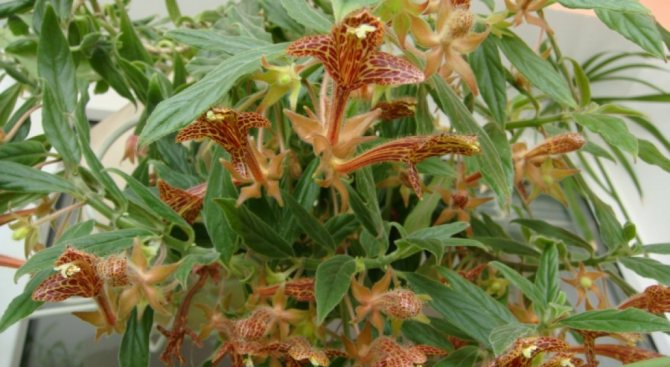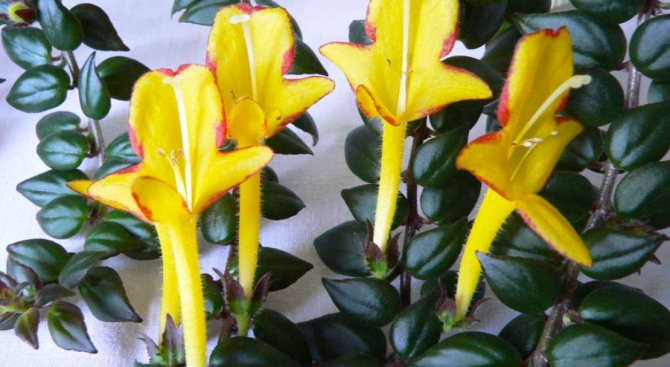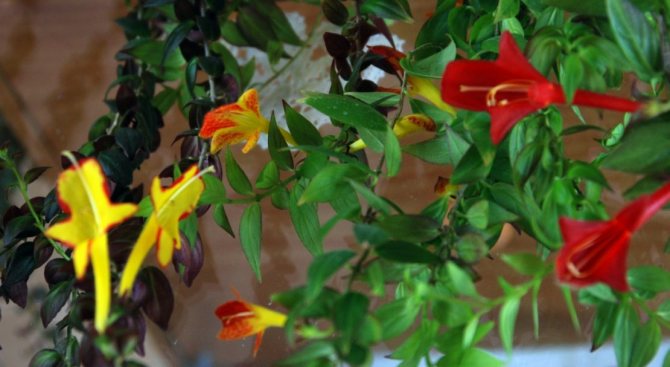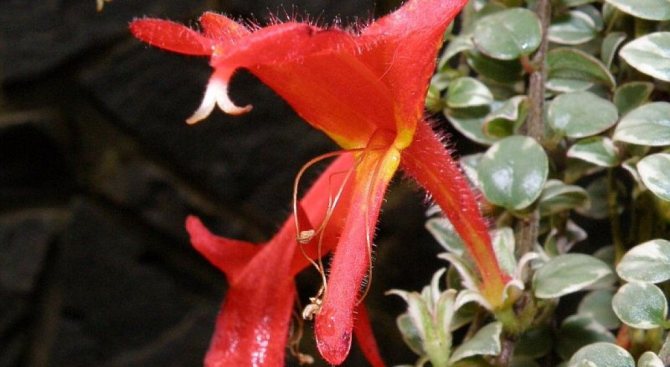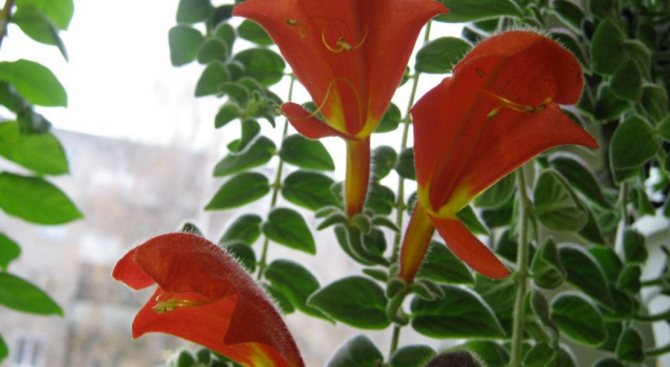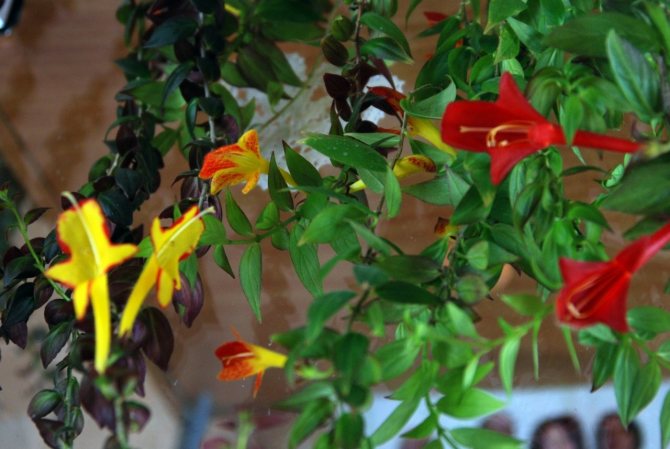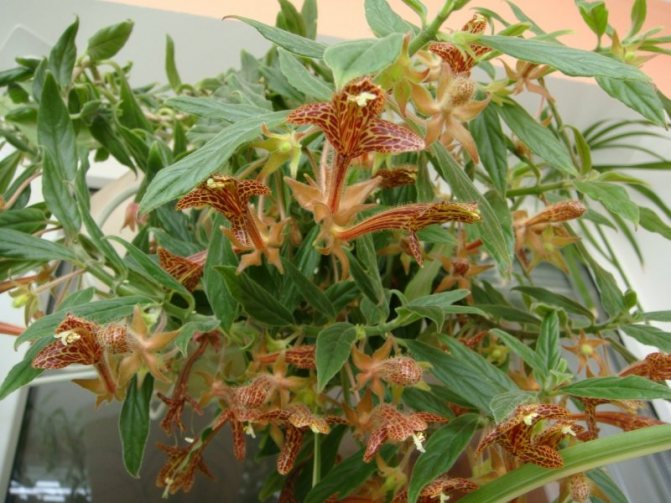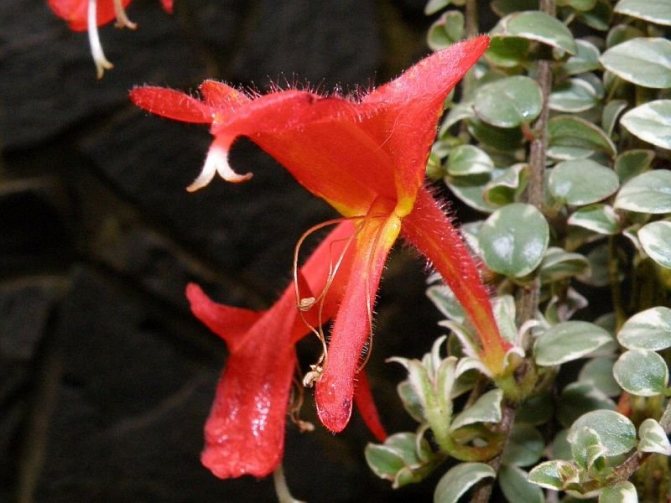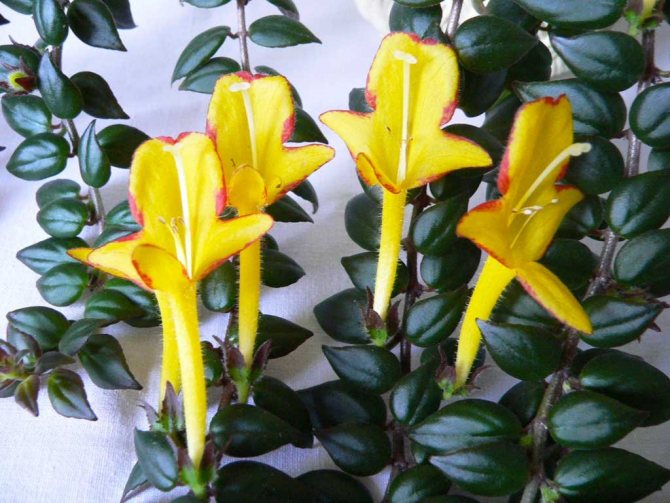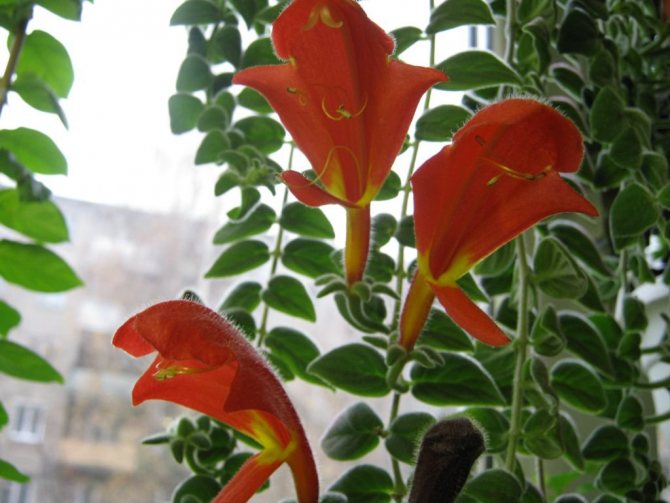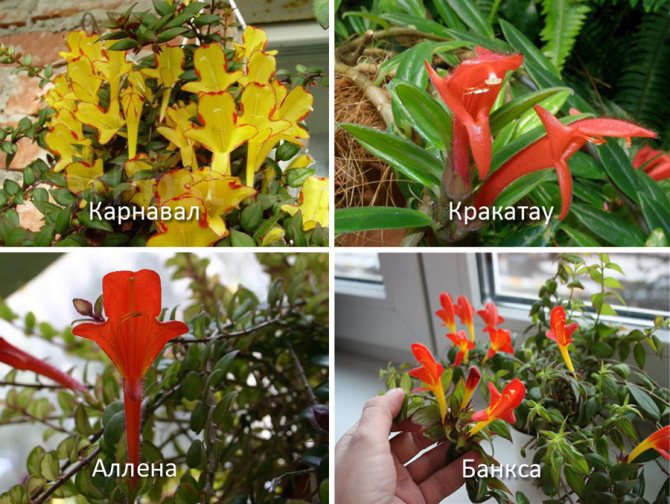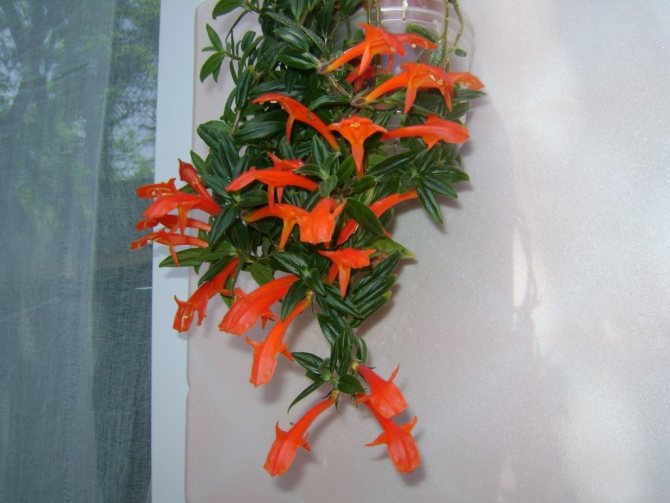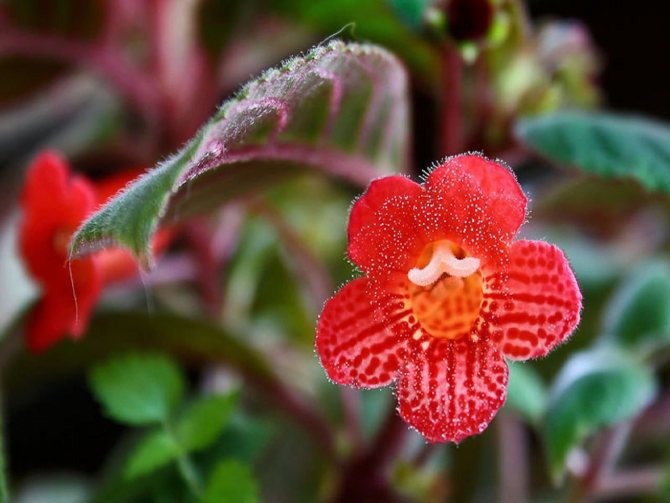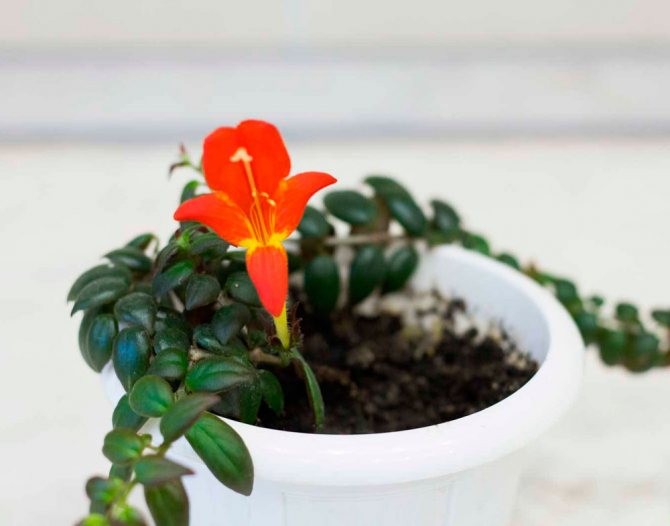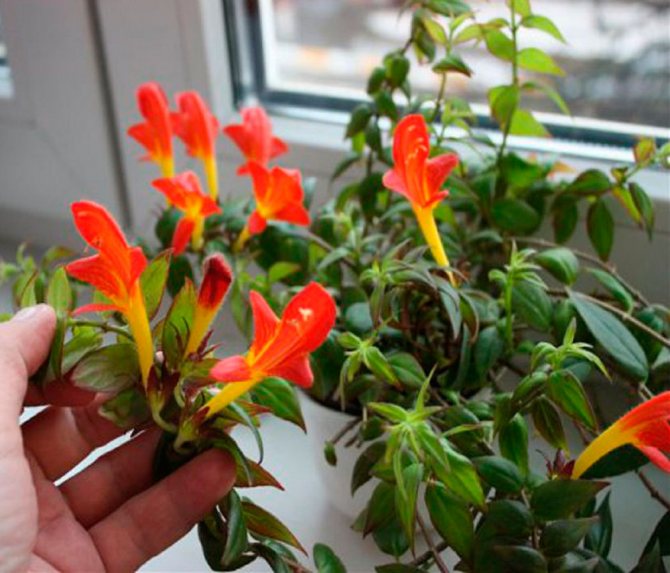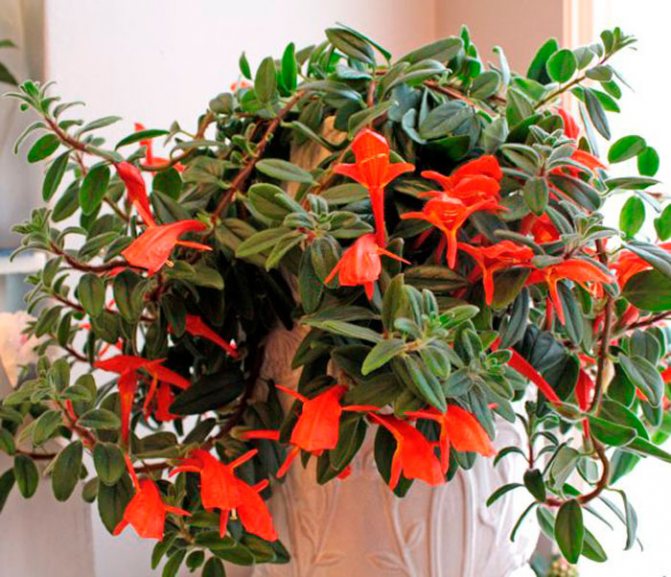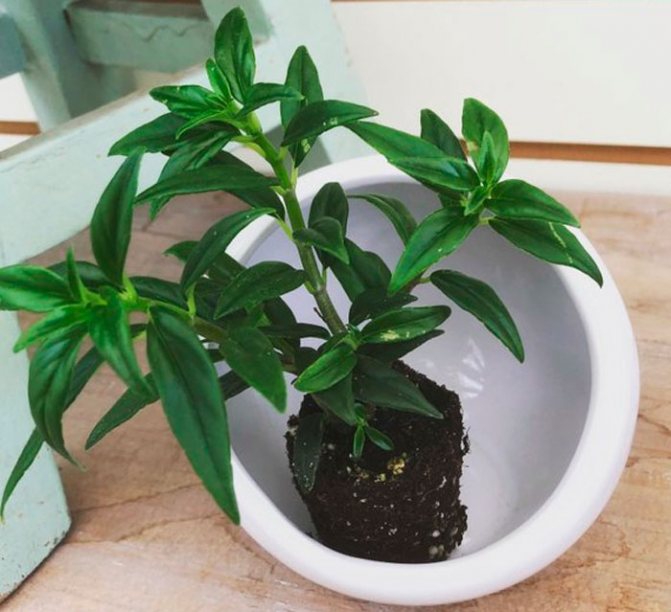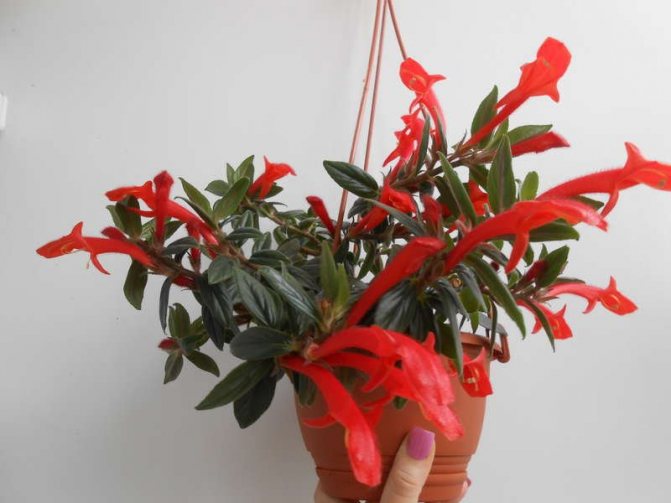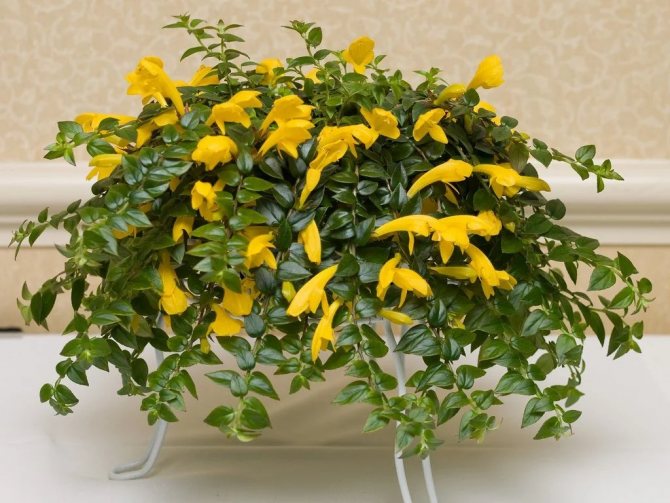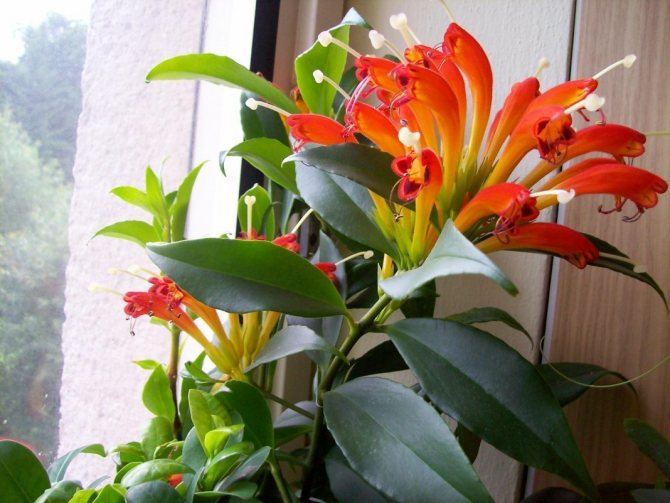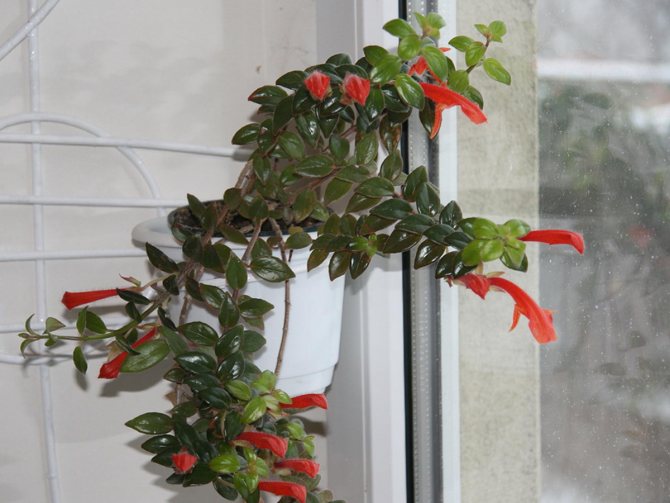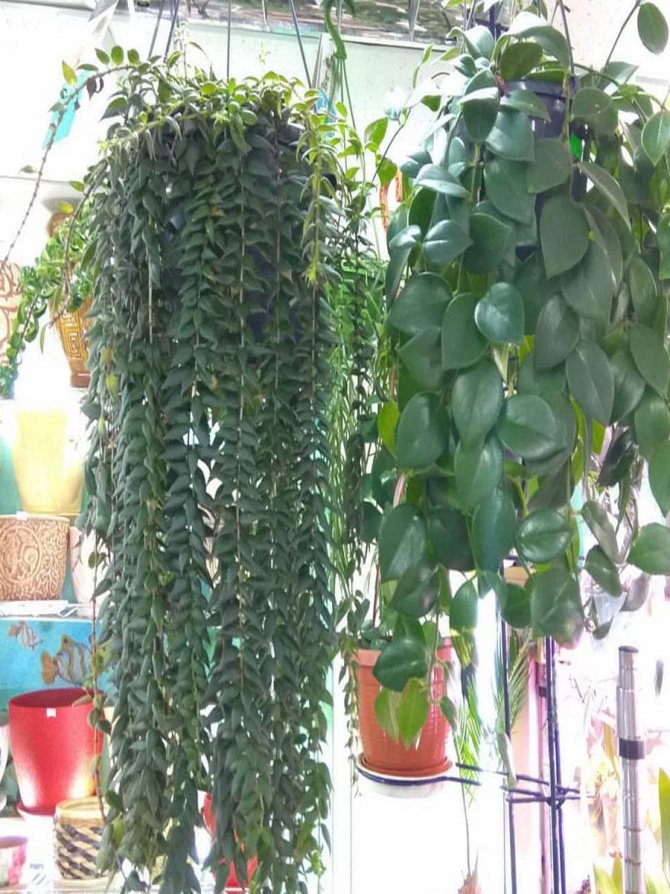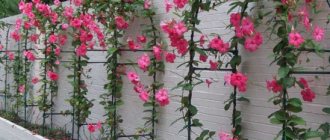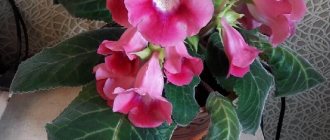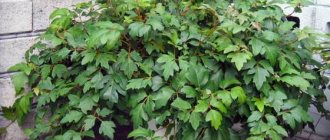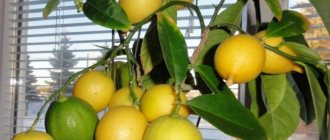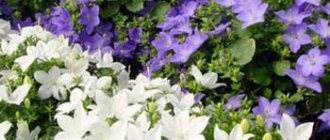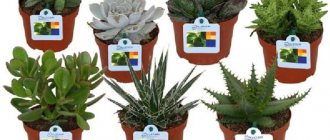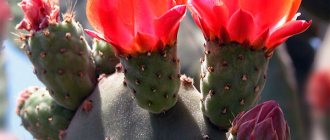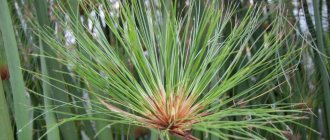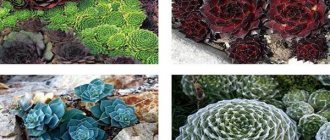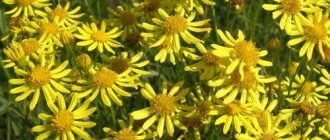Botanical description
Columnea, a dancing dolphin flower, a goldfish is a large genus of perennial flowering plants of the Gesneriaceae family. More than 200 species of columnea are widespread in South and Central America. They often lead an epiphytic lifestyle: similar to orchids, they settle on tree trunks.
At first, the shoots go up, but over time they begin to fall. They are quite fleshy and at the same time fragile, the length is 30-50 cm. In home floriculture, the columnea has become one of the favorite ampelous plants. The leaves are small, oval or heart-shaped with a pointed tip, densely strewn with shoots. The surface of the leaf is smooth or pubescent, the edges of the petals, as well as the shoots, are slightly pubescent. The fluff is silvery, shines beautifully, adding grace and beauty to the plant.
When the color of the columbus
Flowers are bright, like tongues of flame, appear in the axils of the leaves in several pieces. Their shape is tubular, the colors are red, yellow, orange, there may be veins or a border of a different shade. The tube is oblong, and at the top it divides into 4 petals. The upper petal is the largest and widest, similar to a hood, the rest are narrow. The original flowers resemble butterflies or goldfish. Undoubtedly, the blooming columnea is elegant and attractive.
In leaving, the kolumnea is unpretentious, and will delight with variegated flowers in winter or early spring. With proper care, re-blooming in summer is possible. Some species are capable of blooming all year round.
Growing conditions for columnea
Lighting requirements and ventilation
Column lighting loves bright diffused. While the column is small, you can put it on the windowsill, then hang the planter near an east or west window. When exposed to direct sunlight, the leaves begin to fade, spots appear on them (burn marks). During the flowering period with a short daylight hours, it is advisable to supplement the illumination with phytolamps or fluorescent lamps.
An important condition for keeping the plant is protection from direct sunlight and no draft. It is not recommended to take it outside (as well as on an open balcony, etc.).
When exposed to a draft or sudden temperature changes, the leaves fall off the flower.
Air temperature
Provide a moderately warm temperature regime. Keep the temperature between 23-27 ° C throughout the spring / summer period. Columnea will tolerate higher rates, but subject to an increase in air humidity. From late fall to spring, keep the plant in a temperature range of 16-18 ° C. The coolness promotes the formation of flower buds.
How to propagate a columnea
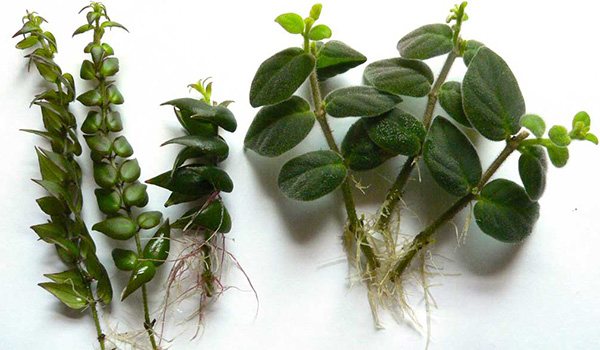
An overgrown plant can be easily propagated by cuttings after the next transplant, then the new flower will retain everything decorative qualities of the parent. Stock up on seeds at home it is very difficult, but if you wish, you can get a rare variety by trying to germinate seeds purchased at the store.
Rooting cuttings
For successful rooting of cuttings, they should be cut with a sterile knife at the end of winter at a distance of 5–10 cm from the top of the shoot. Hold the branches in a rooting stimulator and plant in loose peat. Germinate cuttings at a temperature of at least 23 degrees and moisturize daily.
It is not always possible to maintain in the room favorable conditions for the formation of roots and can decay of the processes occurs, so you can try to put part of the planting material in a glass of water. The liquid level should not exceed 1–2 cm.
This video shows how easy it is to propagate Columnea by cuttings.
Growing from seeds
Columnea seeds have a low germination rate and require ideal conditions for germination.
Recommendations:
- You need to sow planting material on high temperature disinfected peat mixture with sand, without sprinkling on top.
- The container is covered with foil or covered with a jar.
- It is necessary to ensure a constant temperature in the range of 23-25 degrees.
- Airing for 15 minutes and humidification from a spray bottle with soft water is required daily. The liquid should be at the same temperature as the air.
- The first shoots can appear in 3 weeks, and after the formation of 2 leaves, the greenhouse can be gradually removed.
- After at least 2 pairs of leaves have emerged, young plants should be carefully transplanted into separate pots.
Columnea care at home
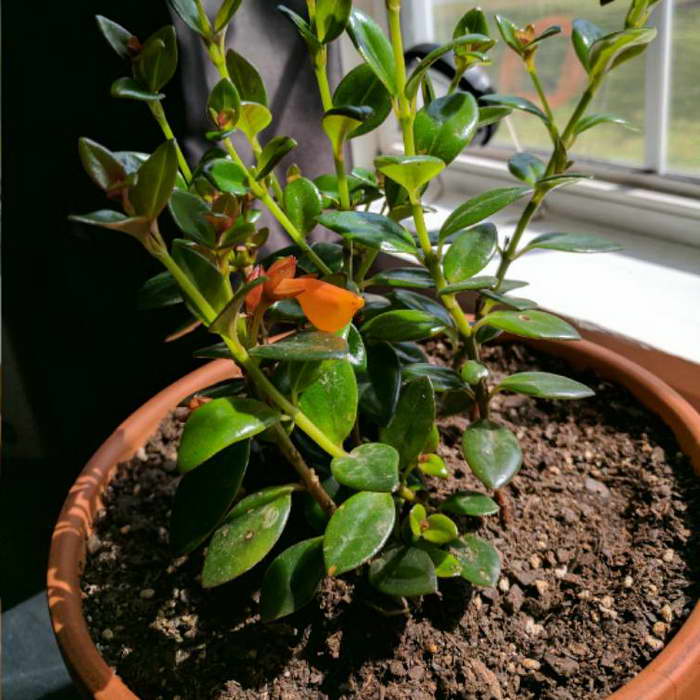

Columney care and growing at home
Air humidity and watering
In caring for a columnea, a sufficient level of air humidity is key, the desired indicator is 80-90%. For this purpose, the plant should be sprayed as often as possible, periodically put on a pallet with humidifiers. Only you need to do everything right: cover a wide pallet with expanded clay or large pebbles, fill it with water, set the pot with the plant on top so that the water does not touch the bottom of the container.
You can use special humidifiers, which is useful not only for plants, but also for humans. Placing an artificial fountain or a regular container of water in the room is another easy way to increase the humidity level in the room.
Water the columnea as the topsoil dries up, do this only with a spray gun. Ideally, the substrate should be just damp and dry slightly on top between waterings. Thanks to the drainage laid during planting, the water in the pot will not stagnate, but remove excess water from the pan. In winter, when the indoor temperature drops, reduce the frequency of watering.
Top dressing
During the growing season (April-October), the columnea should be fed with complex mineral fertilizers for decorative flowering crops. During the next watering, top dressing is applied in liquid form, sprinkling on the leaves (observe the concentration for foliar dressing). Feed at intervals of 7-10 days.
Columnea responds well to phosphate dressings: they can be applied with each watering at a concentration of 25% of the manufacturer's recommended dose.
Pruning Columnea
Every year after the end of flowering, the plant must be pruned. Trim all shoots 1/3 or even 1/2 their length, remove dried shoots, leaves and flowers. After 5-7 years, it is advisable to grow a new columnea from cuttings to rejuvenate the bushes.
Features of home care
When a columnea is grown, home care will be simple. In order for it to develop well and bloom profusely, it is necessary to follow the relevant rules.
Temperature
Fuchsia ampelous - growing and care at home
Columnea is a flower that is considered to be thermophilic. However, it is not suitable for hot, but moderate conditions - 23-27 ° С. In summer, when hot and dry weather sets in, there is no need to artificially lower the temperature. This plant is able to easily tolerate short-term heat, which does not exceed 30 ° C.
Lighting
In the wild, this plant sits in the treetops under the scorching sun. In a city apartment, such conditions can be provided by placing a flower on a windowsill by a well-lit window. In this case, you need to take care that direct sunlight does not fall on the flower.
Watering
The frequency of watering is determined by the condition of the soil.The need for it arises when the topsoil becomes dry. During the summer, it is usually carried out every other day, and in the summer or autumn - once every three days.
Important! During the dormant period, watering the flower is enough 2-3 times a month.
Spraying
For the normal development of the plant, it is necessary to spray the leaves with water at room temperature. This should be done daily or at least every other day. For this, it is necessary to use settled water at room temperature.
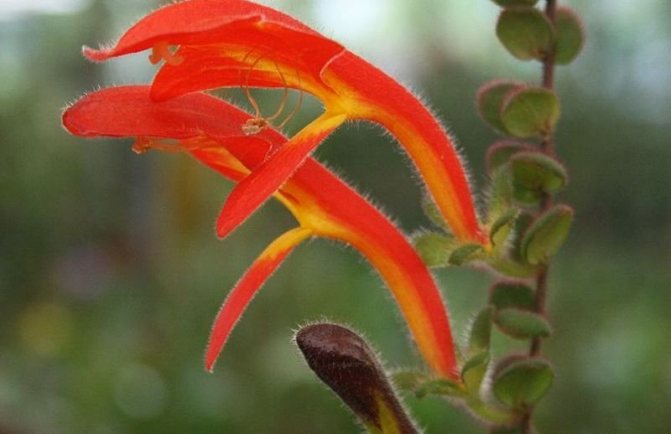

Columnea flower
Humidity
High humidity is favorable for flower development. To maintain it, regular spraying of the leaves is carried out.
Note! If growing a smooth-leaved variety, it is helpful to rinse the dust off the leaves under the shower. Pubescent species are not recommended to undergo such a procedure.
Priming
For cultivation, you need a fertile and loose soil. You need to add a wooden substrate to it, for example, chopped bark. There should be a drainage layer at the bottom. You can buy ready-made soil for epiphytes in the store.
Top dressing
When active growth occurs, the columnea is fed twice during each month. Fertilizers with a high nitrogen content are needed in early spring. They will promote growth.
During the period when flowering occurs, the plant needs fertilizing containing a full range of essential substances. For this purpose, you can purchase fertilizer in a specialized store that is intended for Saintpaulias.
Important! When the dormant period approaches, fertilizers are applied no more than once a month. It is preferable to use those that contain vermicompost or other organic substances.
Support
Sometimes the severity of the shoots forces the flower to bend over. In this case, you can provide them with support. You can also grow a columnea so that the shoots are located on a horizontal plane.
Transfer
The need to carry out a transplant for breeding arises in cases where the columnea has grown too much. This must be done before the onset of the dormant period or in early spring before the end of active growth.
The new pot should be 3-5 cm deeper than the roots have grown. The bottom must be covered with a drainage layer. Perlite and pieces of wood are added to the soil.
Pruning
Pinching shoots will stimulate the formation of new ones. This must be done in late autumn. During the winter, new points of plant growth are formed.
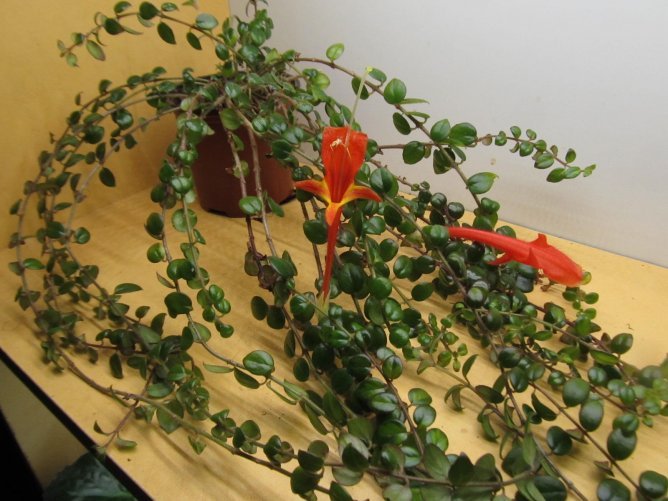

Growing a flower on a table
Transplanting columnea after planting and during the growing season
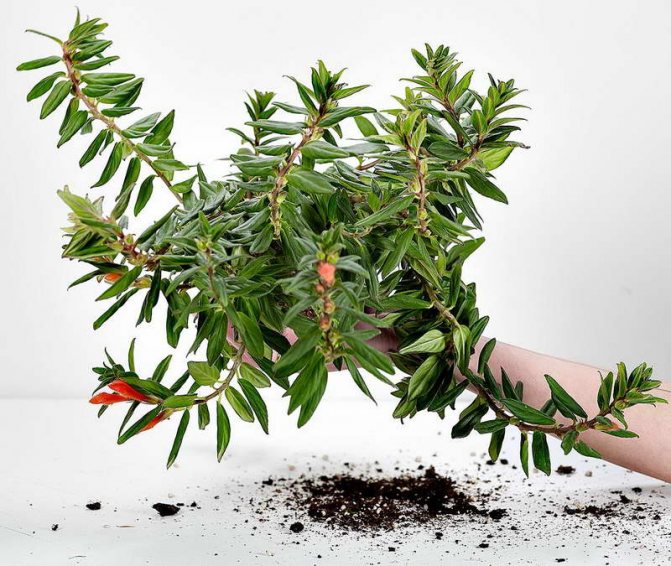

How to transplant a columnea correctly
The root system of the columnea is fibrous and sensitive to transplantation, so transfer with an earthen lump. Perform the first transplant immediately after purchase, then transplant as the substrate is filled with roots. Transplant in early spring.
Important: When transplanting, cut off one third of the roots with a sharp knife every two years to stimulate rejuvenation of the bush. Otherwise, over time, the flower will degenerate.
The transplant tank is medium sized and shallow. At the bottom of the pot, lay a drainage layer consisting of expanded clay, pebbles or pieces of foam (you can mix it).
At the flower shop, you can purchase a versatile substrate. Prepare the soil mixture yourself if desired. You will need 4 parts of sod and leafy soil, 2 parts of peat and 1 part of sand, add a little sand and charcoal.
Columbia care and reproduction
Columnaea is undemanding to care for. The flower can be constantly in the room. Even beginner growers can take care of a flower.
Location and lighting
It is very important to choose the right place to place the column at home. In natural conditions, the Goldfish grows on the trunks of tropical trees and has long vines, so a hanging planter or a tall pot would be the best place for it.
Columnea is an epiphyte, so its root system does not provide the plant with nutrients, but only serves as a support and anchorage.
If the location of the flower is unsuccessful, it stops blooming and may die.
The plant needs good lighting. an ideal place for a columnist would be the east or west side with diffused lighting. Direct sunlight can burn the delicate leaves of Columnea, causing discoloration of the leaves and the appearance of whitish spots. In this regard, in hot weather, it is necessary to take care of the shading of the plant.
In winter, with a lack of light, you need to take care of additional lighting, for which you can use fluorescent lamps or phytolamps.
Watering plants and moisture
Under natural conditions, columnea grows in humid tropical forests, therefore, in a home environment, it requires a high level of humidity, close to natural.
In order to increase the air humidity in the room, it is recommended to spray the plant daily with warm water from a spray bottle.
For this purpose, you can put pots with a flower on a pallet on which there is moistened expanded clay, pebbles or moss. When placed on pallets, the roots of the plant should not come into contact with water, as this can lead to rotting or the development of root rot.
To increase the humidity level, you can place the flower next to an aquarium or artificial fountain.
For watering the columnea, it is recommended to use warm settled water without chlorine impurities. The content of harmful impurities in the water can lead to the formation of stains on the leaves.
The flower does not have a pronounced rest period. In winter, when the plant does not bloom, you can stop additional lighting, reduce watering and fertilization. The temperature should be lowered to 18 degrees. At this time, the formation of flower buds will begin. After 30 days, the plant should be moved to a warm, bright room and kept at temperatures up to 25 degrees. If the rest period is prolonged, then keeping at a low temperature and rare watering will not bring the desired result. Columnaea may not bloom.
Plant transplant and soil
With proper care, the columnea is distinguished by its rapid growth. At the end of the flowering period, leaves begin to fall off, the stems become bare and the plant loses its attractive appearance.
As a rule, the rejuvenation of the plant is combined with its transplant. To do this, remove most of the leaves from the shrub and plant several shoots in a spacious pot.
The flower has a small and very weak root system, so the plant does not tolerate transplants well. They are carried out only when necessary with a strong overgrowth of the bush.
The plant requires a shallow medium pot or hanging planter, on the bottom of which a drainage layer is laid. Fine crushed stone, pebbles, expanded clay or pieces of polystyrene can be used as drainage. After that, the soil is laid.
Planting a plant can be carried out in a ready-made soil mixture for epiphytes; it can also be prepared independently from leaf and sod land, peat, coarse sand, charcoal and moss.
The transplant is carried out by the transshipment method so as not to damage the plant's root system. If the transplant of the columnea is not required, then the shoots are pruned once every three years.
Reproduction of columnea at home
At home, columnea is propagated by cuttings or sowing seeds.
Cuttings
- This is the easiest and most convenient way to breed a plant. In early spring, shoots up to 10-15 centimeters long are cut from the top of the shrubs, on which there are 2-3 pairs of leaves. Shoot rooting can be carried out in water or nutritious peat soil.
After planting, the cuttings are covered with a glass cover to maintain a constant temperature and humidity level. The containers are kept in a bright, warm room. Watering is carried out daily.
Once the roots and a new pair of leaves have emerged, the plant can be transplanted into a small pot and placed in its permanent location. Care for young plants is the same as for adult plants.
Seed propagation
This breeding method is very laborious and does not always bring a positive result. It is usually used by experienced gardeners or breeders to breed hybrid varieties of the plant.
Sowing seeds is carried out in the soil, consisting of sand and peat. The seeds are sown on the soil surface. After that, the containers are covered with foil or glass and placed in a room with an air temperature of up to 26 degrees. Maintenance consists of daily airing and watering. The first shoots appear in 7-20 days. Containers with seedlings are placed in a bright place, protected from direct sunlight. When 2-3 pairs of real leaves appear on young plants, they are transplanted into small pots without picking.
Growing Columnea from seeds
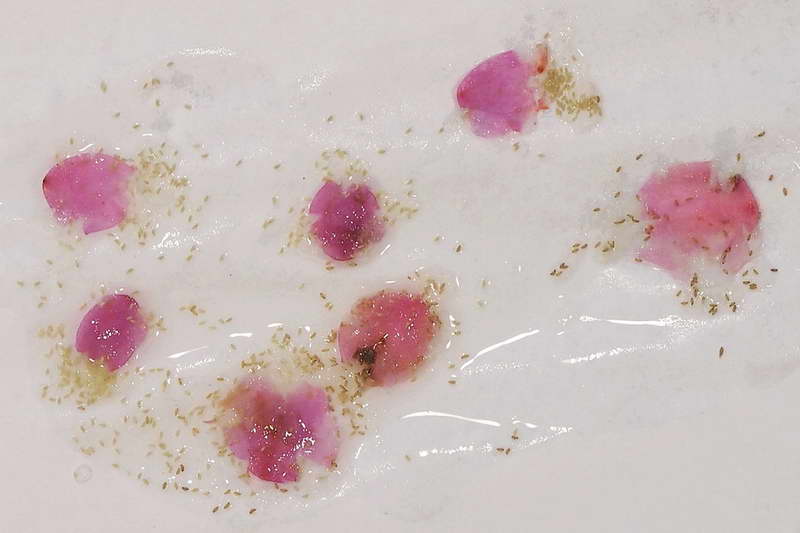

Columnea seeds photo
For indoor reproduction, the seed method is not often used, since the germination rate is average, and not all sprouts that appear will survive. Experienced and patient growers resort to seed propagation.
- For sowing, it is necessary to prepare wide containers with a sand and peat mixture.
- Sow in late winter and early spring.
- Moisten the soil by spraying from a fine spray, distribute the seeds evenly over the surface and sprinkle with a thin layer of substrate (like salt).
- The creation of greenhouse conditions will be required. To do this, cover the crops from above with transparent glass or film, place the container under bright diffused lighting and maintain the temperature regime in the range of 23-25 ° C.
- Raise the cover daily to ventilate (remove condensation from the inside of the glass with a cloth).
- Irrigate crops with a fine spray as needed. Expect sprouting after 2-3 weeks. After that, remove the shelter.
- The sprouts will need bright lighting, but not in direct sunlight. If there is not enough natural light (the sprouts are strongly stretched), additionally use phytolamps or at least fluorescent lamps.
- With the appearance of 3-4 real leaves, place the columnea in separate containers.
Reproduction of columnea by cuttings
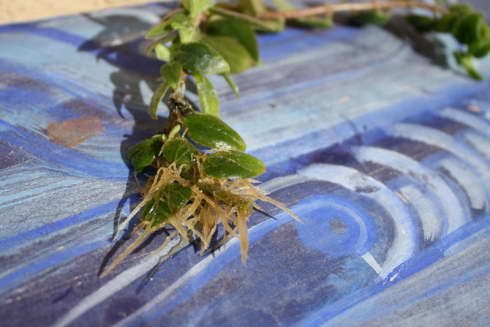

How to root a columnea stalk photo
It is most convenient to propagate the columnea vegetatively - by rooting cuttings. They need to be cut in February-March.
- Each stalk should be at least 8 cm long and have 4-5 leaves.
- Mix the universal substrate with peat and perlite, plant the cuttings, deepening 1 cm into the soil and moisten the soil from a spray bottle.
- You can completely cover the container with glass / clear film or each handle with an individually cut plastic bottle / glass jar.
- Place in a warm place (21-24 ° C) with diffused lighting.
- Do not forget about the need for daily ventilation, as the soil dries up, spray the substrate, but do not overmoisten.
- When a couple of new leaves appear, you can plant them in separate containers with soil for adult plants.
Columnea also allows propagation by cuttings in water: put the cuttings in a solution with a rooting stimulator for a day (heteroauxin, root), and then put them in plain water. Keep on a light, warm windowsill until roots appear, then plant in permanent pots. Remember that there is a risk of rotting when rooting in water, so change the water every day to avoid the buildup of rot pathogens.
Transfer
The roots of the culture are sensitive and fragile, therefore, it is not recommended to transplant it unless absolutely necessary. A transplant is usually needed if the grown plant no longer fits in the pot.
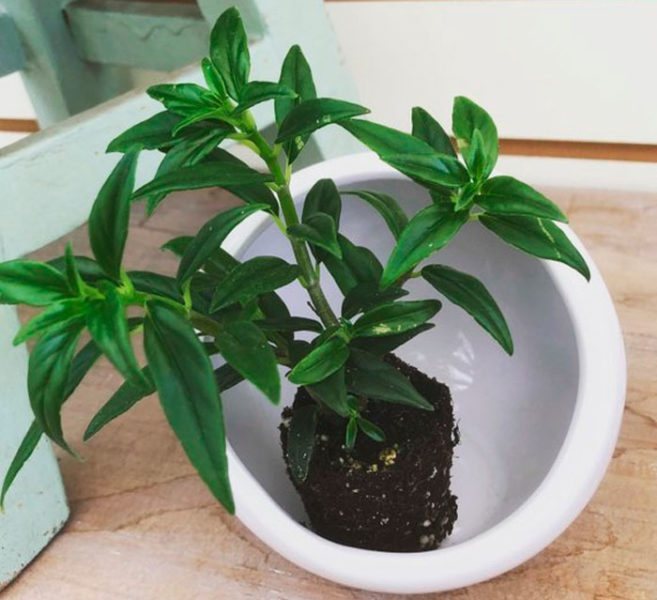

Columnea transplant
The plant is transplanted to a new place along with a lump of earth. In this case, you need to try to injure the roots as little as possible.
Diseases and pests
From excessive watering and stagnant moisture, a fungal infection begins to develop and the plant is affected by gray rot.It is better to act in the early stages: cut off the affected areas, and treat the cuts and the substrate with a fungicidal preparation, be sure to normalize watering.
With a severe lesion, an emergency transplant will be required:
- Remove the plant from the container, shake off the earthen ball and cut off all affected parts of the plant (including roots), disinfect the cut sites with a fungicide and transplant the columnea into a new container (to use the old one, it must be disinfected with a fungicide).
- If during transplanting you find that the plant is badly rotted, cut the cuttings from the surviving shoots and root.
Columbians do not note other diseases.
Among pests, a spider mite, aphids, scale insects, and thrips are dangerous for columnea. This will not happen if you take proper care of the plant. Inspect juicy stems and leaves periodically. Aphids are small greenish or black insects that are clearly visible and "occupy" the leaves and tops of the shoots.
The spider mite leaves a discharge in the form of whitish cobwebs. Scabbards are insects with shells that form dark tubercles on the stems, thrips are oblong beetles of brown or black color. When damaged by any pest, the plant will begin to lag behind in growth, the appearance will be depressed (the leaves curl, turn yellow, fall off). It is necessary to carry out treatment with an insecticidal preparation, which is sold in any flower shop. Proceed according to the instructions, several treatments may be required if the pests do not recede.
Temperature regime
The room where the columnea is located should be kept at a temperature of 23-28 ° C. If the room is hotter, then it is necessary to maintain sufficient humidity.
In the cold season, you can stimulate the laying of new flowers. To do this, the plant should be placed in a cool place with a temperature not exceeding 18 ° C.
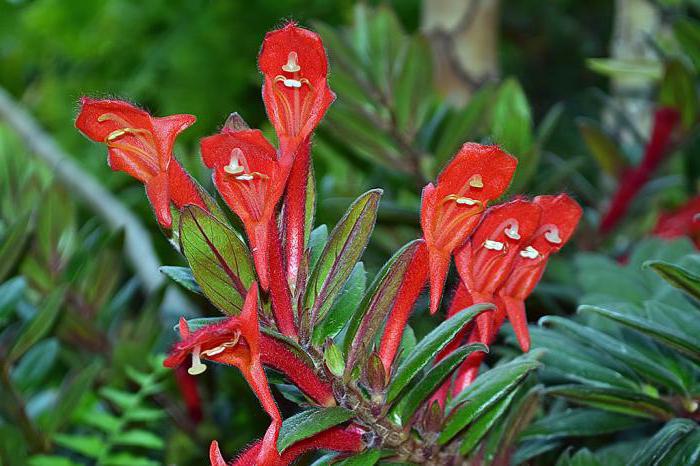

Columbus in the house
Columnea types with photos and names
As mentioned at the beginning of the article, the genus Columnaeus has about 200 species. Consider the best of them - the favorites of home floriculture.
Columnea Carnival
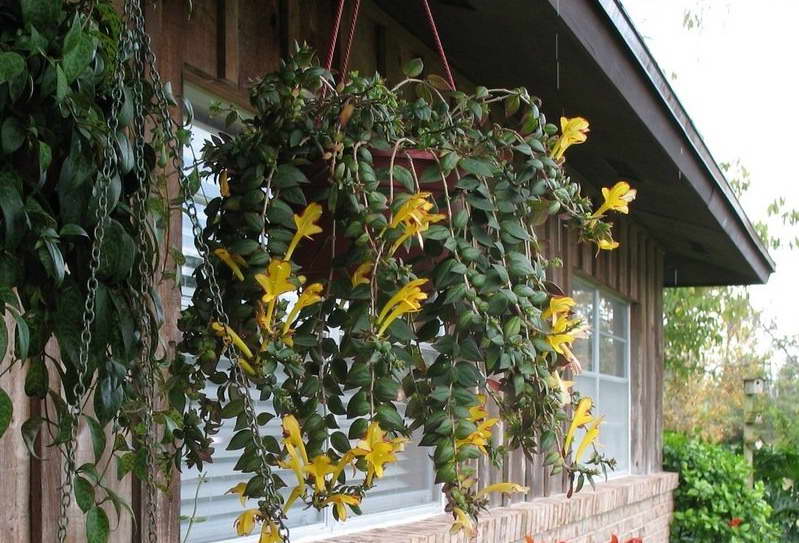

Columnea Carnival Columnea Carnival photo
The shoots are decorated with leaves of a dark green hue. The flowers are sunny yellow with a thin red border.
Columnea Ecuadorian Columnea orientandina
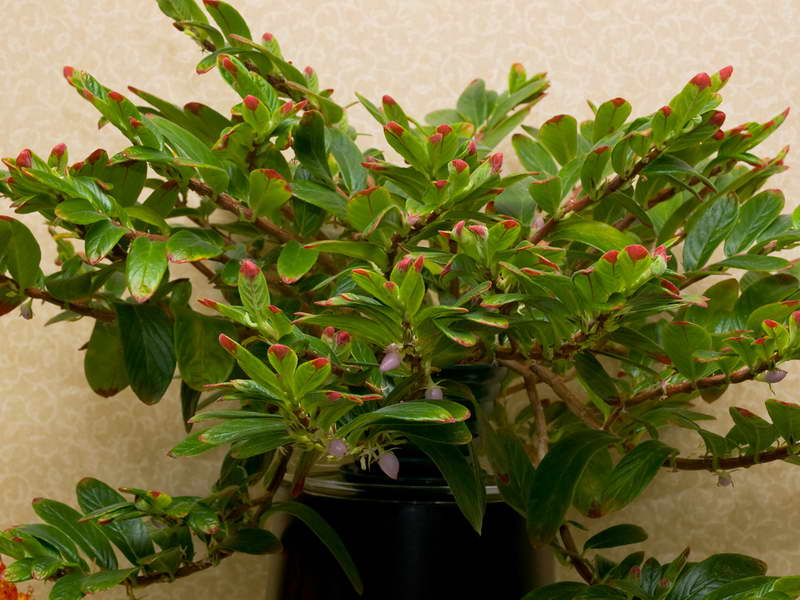

Columnaea Ecuadorian Columnea orientandina photo
The combination of small bright yellow flowers, huge pinkish lavender berries and glossy leaves with red tips makes a lasting impression. Unlike many of the more common species in the genus, C. orientandina has a distinct erect shoot shape. The sturdy stems are woody and tough. Separately located flowers produce a lot of pollen.
Columnea medical Columnea medicinalis
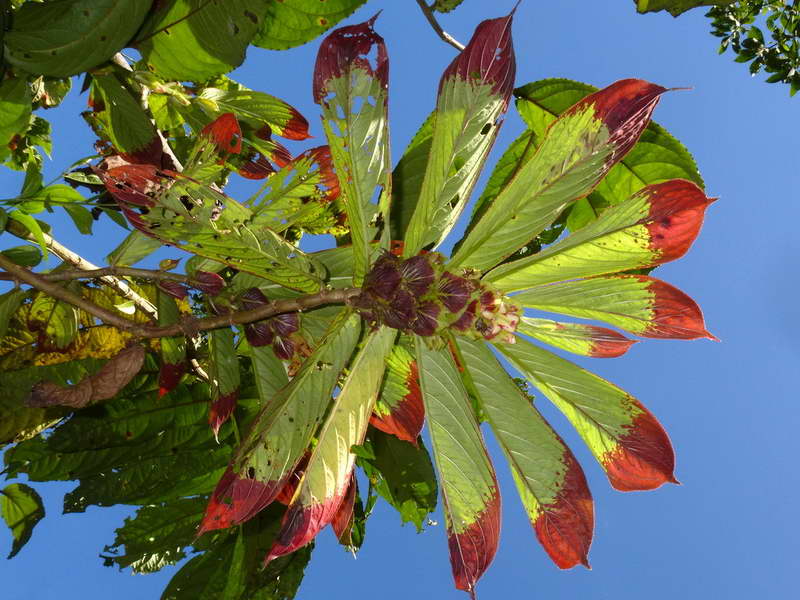

Columnea medicinalis Columnea medicinalis photo
An exotic woody liana with fan-shaped leaves, inexpressive inflorescences are located in the center of the same rosette. The attractiveness is the contrasting color of the leaves: light green turns into blood red at the tips.
Columnea purpureovittata Columnea purpureovittata


Columnea purpureovittata Columnea purpureovittata photo
Columnea purpureovittata is notable primarily for its dramatic downy foliage, which is very dark and extremely wrinkled, meaning it has a bubbly and bumpy texture unlike most Columnea species. An adult plant is striking, especially when the yellow and maroon inflorescences densely cover the plant.
Columnea Allen Columnea aliena
Shoots grow quickly, in the absence of pruning, the plant will turn into a vine 4-6 m long. The flowers of this species are bright red.
Columnea Krakatau
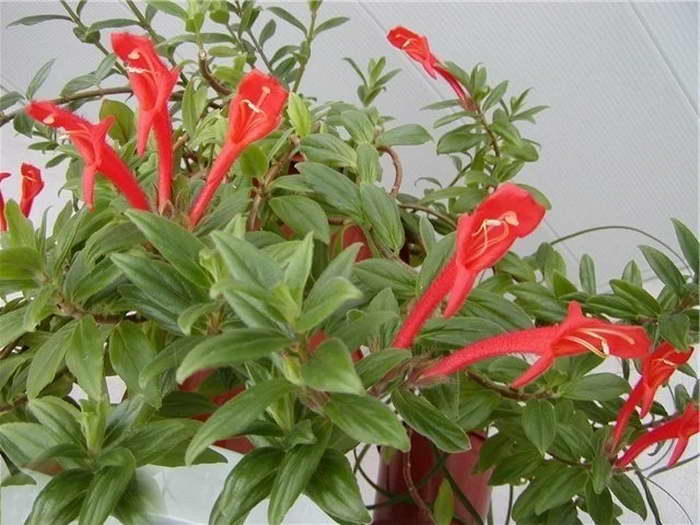

Columnea Krakatau Columnea Krakatau photo
The shoots are raised from the base, hanging beautifully over the edges of the pot. The leaves are small, oblong. Flowers are uniformly colored in a red-orange hue.
Columnea lehmannii
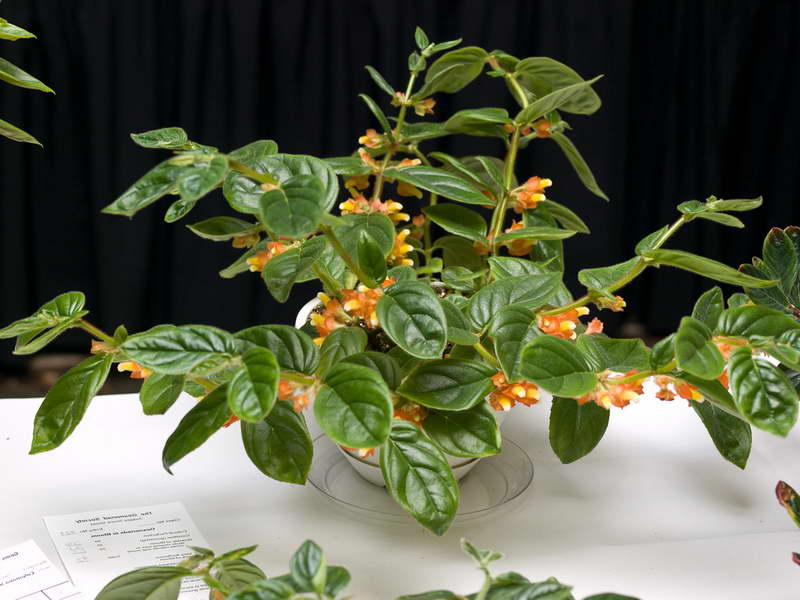

Columnea Lehmann Columnea lehmannii photo
A very compact plant that develops well in indoor conditions.The leaves are decorative: they look like violet leaves, they are very thick, with pronounced veins, shiny and slightly pubescent. The flowers are small, yellow-orange in color, collected in loose inflorescences located under the leaf axils.
Columnea minutiflora Columnea minutiflora
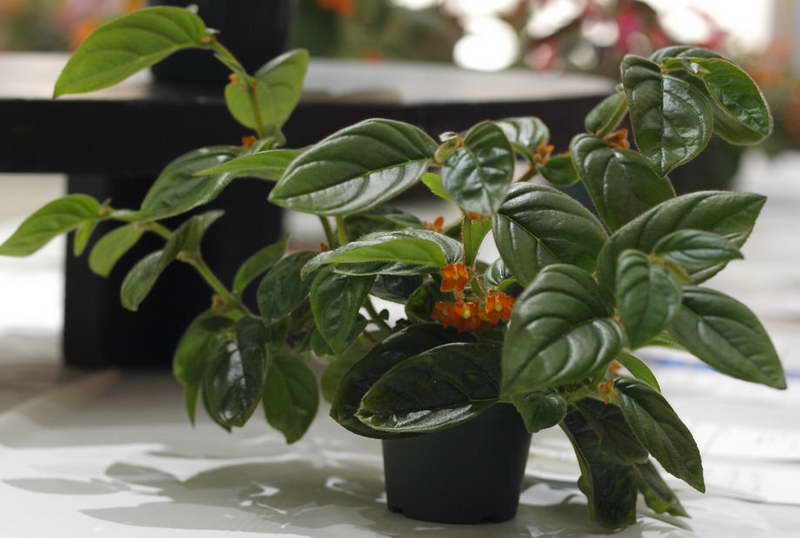

Columnea minutiflora Columnea minutiflora photo
Luxurious large fleshy leaves of this columnea species are the main advantage of the plant. Bright, saturated tones of green, glossy shine and slight pubescence delight indoor florists. Stems are tough, erect. Small orange flowers with yellow centers are inexpressive, but add charm to the flower.
Columnea hirsuta
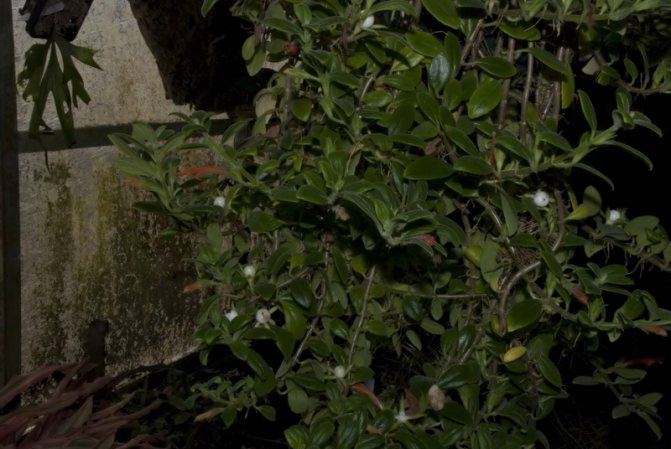

Columnea hirsuta Columnea hirsuta photo of a plant with flowers and berries
Powerful thick cascading shoots are covered with fleshy oval-pointed leaves with slight pubescence and glossy shine. The flowers are tubular, rare; after flowering, white round berries are formed.
Columnea linear Columnea linearis
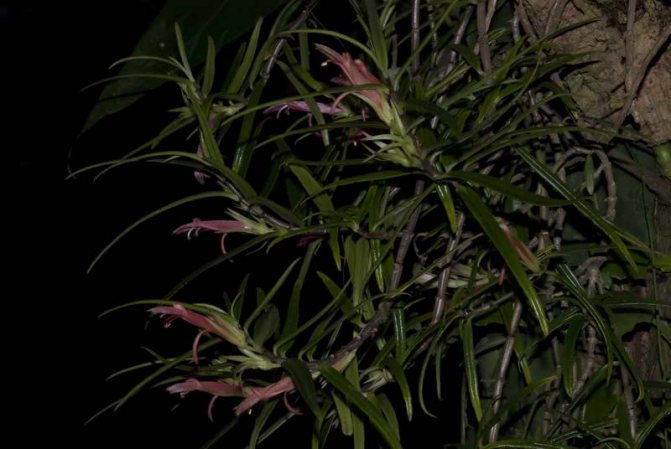

Columnea linear Columnea linearis photo
Long narrow leaves radiating from thick flowing shoots give a fantastic appearance to the plant. The image is organically complemented by long tubular flowers of a pale pink color, collected in inflorescences of two and located under the leaf axils.
Columnea ciliata Columnea ciliata
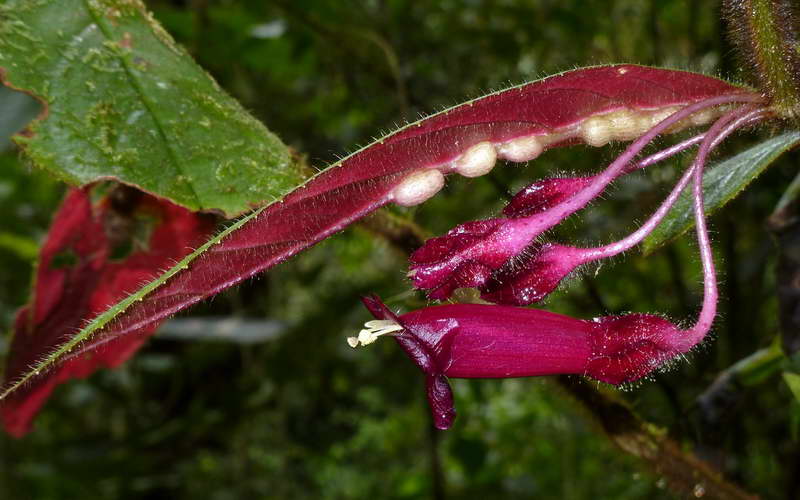

Columnea ciliata Columnea ciliata photo
The beauty of the species is in the exotic inflorescences of tubular flowers that bloom in turn. The leaves are green, pubescent, on the reverse side they have a purple hue, identical to the color of flowers.
Columnea small-leaved Columnea microphylla
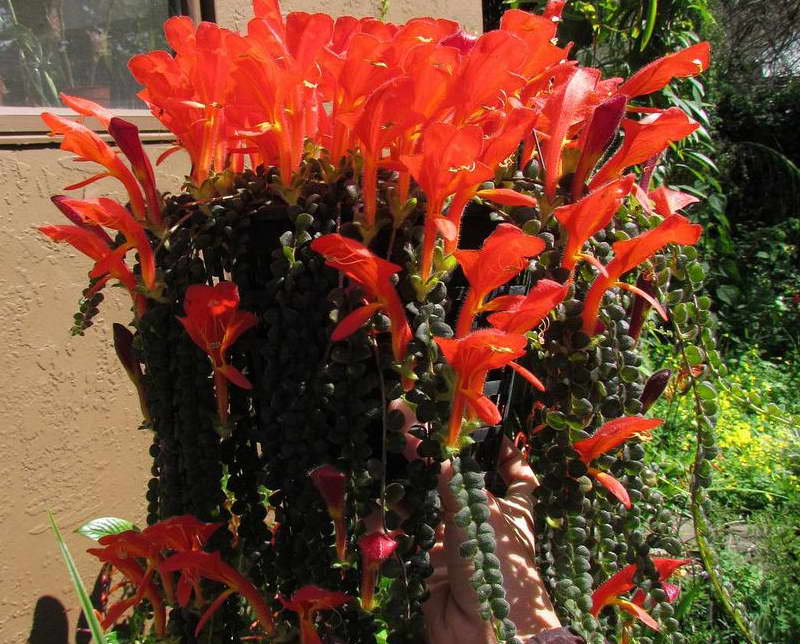

Columnea small-leaved Columnea microphylla photo
Columnea microphylla is a tropical plant from the moist forests of Costa Rica. In the wild, they grow as epiphytic plants, settling down on rotten tree trunks or digging into the crevices of boulders, taking root somewhere where plant debris has accumulated. In their natural habitat, the roots are constantly in a humid environment, and excellent drainage ensures that there will never be stagnation of moisture. These plants need a dormant period with a cool content in order to bloom profusely.
Columnea microphylla is an impressive spring flowering plant with slender, branching stems up to 2.5 m long, which are densely covered with brownish-red hairs. The stems have almost overlapping pairs of leaves of the same size, almost round, dark green in color, up to 1.5 cm in diameter; they are also densely covered with reddish hairs.
The flowers, located on tiny pedicels, have pubescent calyces, colored green and red. Flower corollas are bright scarlet, with a yellow throat, up to 9 cm long. Flowers emerge from the leaf axils, with a brightly shaped five-lobed calyx.
Each tubular rim flies into five blades of various shapes. The two upper petals are joined together to form a lower curved hood above the others. When the flower opens, its stamens can only be seen under the outer end of the hood. This form of colorful open flowers has given Columnea microphylla its peculiar name - the goldfish plant, as the flowers at different angles resemble a side view of a fish.
Up to 100 flowers can bloom at the same time on one large plant, and each flower can last for four weeks. The flower is followed by an attractive, often white berry clamped in a cup. This plant looks best in a hanging basket. It is very important to prune this species after flowering.
Columnea acute Columnea arguta
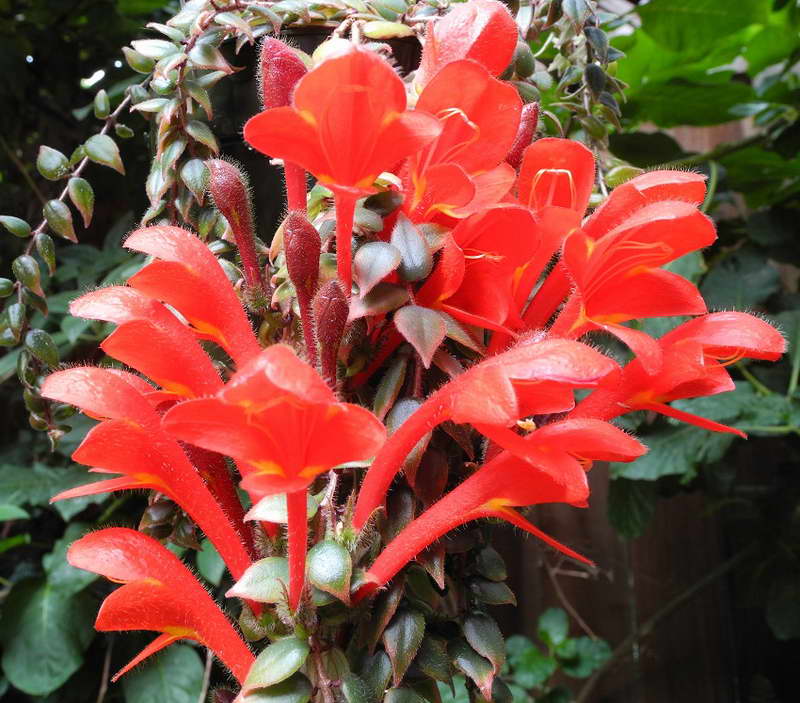

Columbus arguta Columnea arguta photo
This super-showy African purple columnea species produces cascading chains of leaves adorned with giant, scarlet and yellow flowers. Shoots of this species can grow impressively long - up to 1.8 m or more! This flower is difficult to obtain, but very easy to grow at home.
Columnea arguta
found in Central and South America, where it grows like an epiphyte on trees. It looks amazing when kept in a hanging planter, but the plant can also be grown along a wall, waterfall, etc. Succulent leaf chains grow in tears quite quickly and can be cut to any length.
Flowers appear in the axils from older sections of the stems. At 7-8 cm long, they are surprisingly large, especially when compared to small leaves. The flowers are reddish-orange in color with 4 yellow petals, followed by attractive white berries surrounded by red bracts. This species can interbreed with several other Columnea species to create great new hybrids!
It is a tropical species that requires mild and warm conditions throughout the year. It grows well indoors with daytime temperatures around 24 ° C and nighttime temperatures around 18 ° C. Loves bright, diffused light, protected from strong sun. A typical potting mix is 2 parts perlite to 1 part coconut fiber or peat moss and should be slightly moist at all times. Or use equal parts of potting soil and fine-grained orchid bark. More than 50% humidity is best for these rainforest dwellers.
Columbus Raymond Columnea raymondii
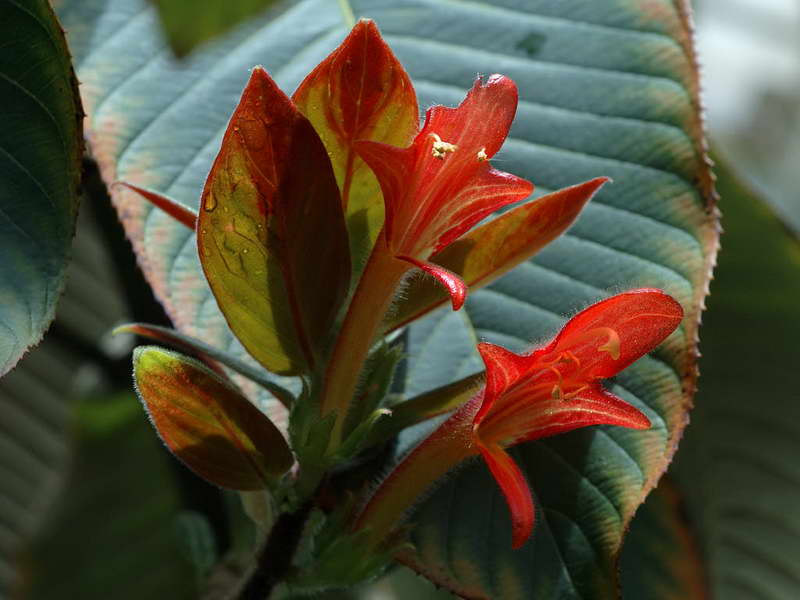

Columbus Raymond Columnea raymondii photo
A plant with large paired lanceolate leaves with pronounced veins. Shoots are powerful, erect and drooping. The flowers are tubular, with contrasting veins, have four petals, the upper one in the form of a wide hood. The colors are very diverse, mainly bright red and orange, varieties with completely purple colors of both leaves and flowers have been bred.
Columnea the majestic Columnea magnifica
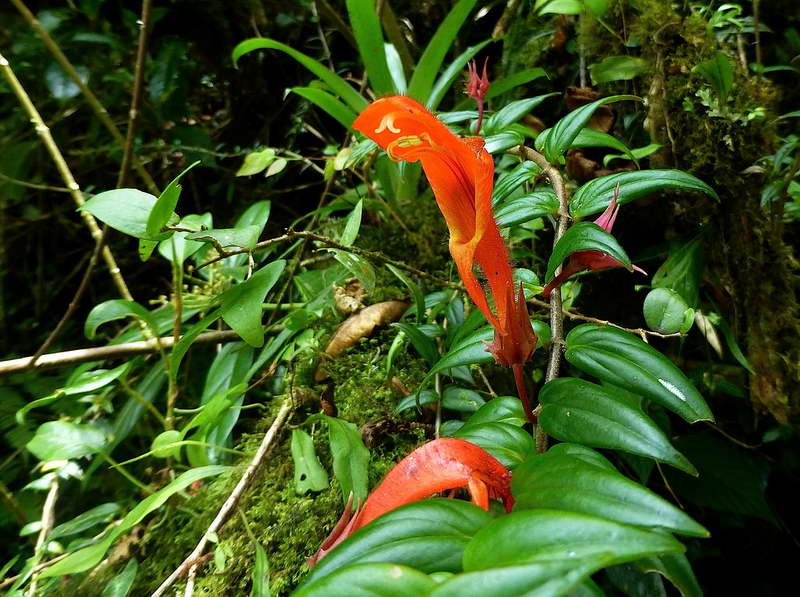

Columnea the majestic Columnea magnifica photo
Differs in rather large sizes of shoots, leaves and flowers. Leaves are dark green, glossy or pubescent, lanceolate, elongated-pointed, arranged in pairs on powerful drooping shoots. Flowers of bright red color on short stalks effectively rise above the liana, having an unusual shape, reminiscent of a tube with a funnel, which is covered from above by a drooping hood, and from below is decorated with a narrow long "beard".
Columnea thick-leaved Columnea crassifolia
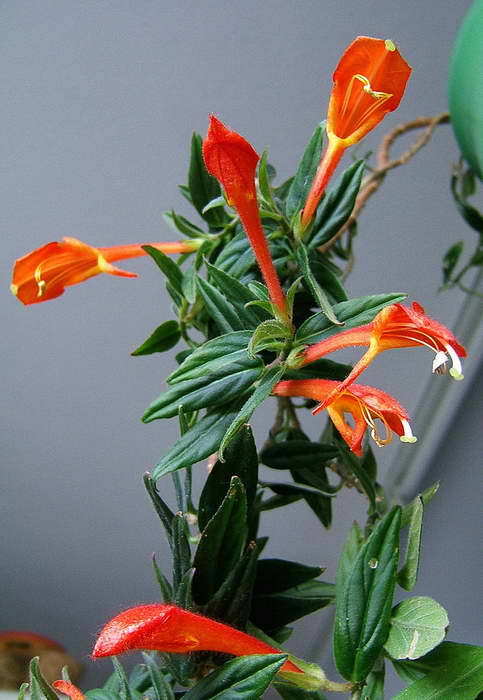

Columnea crassifolia Columnea crassifolia photo
A shrub common in Mexico and Guatemala. Blooming in spring. Long single flowers (8 to 10 cm), orange-red.
The stem is erect, powerful. The height and width of the bush is up to 30 cm. Long wrinkled leaves (up to 10 cm) are narrow, dark green shiny pubescent, paler on the back.
Columnea variegated Columnea variegata
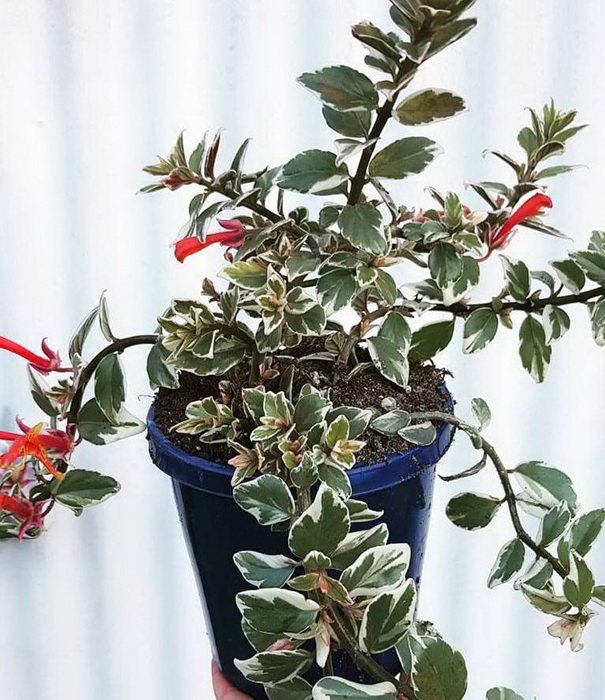

Columnea variegated Columnea variegata photo
Variegated form with unusual green and white color of the leaves. The edging can be along the edge of the leaves or on one side. Sometimes the shoots at the tips are whitish, and darken over time. It all depends on the variety!
Columnea blood red Columnea sanguinea
The name of the species is due to the shade of the flowers. Shoots are long and thickened. Feature of the plant: there are vague burgundy specks on the back of the leaf plates.
Columnea gloriosa or glorious Columnea gloriosa
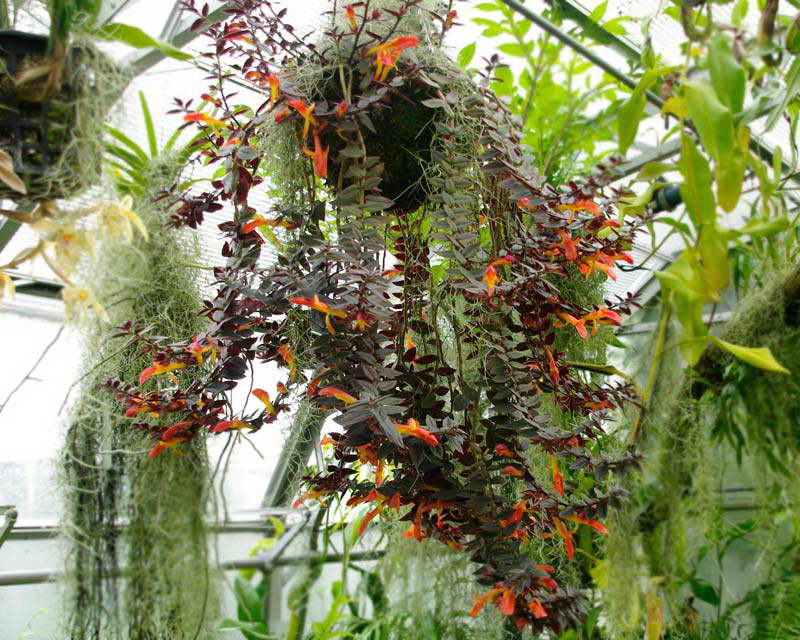

Columnea gloriosa Columnea gloriosa photo
It is an evergreen epiphyte with long flowing shoots and bright flowers. The leaves are purple, fleshy and heavily pubescent. The shade of flowers is orange-red. Ideal for ampel cultivation. He loves a humid warm environment, in winter a dormant period is required, in spring and summer - liquid top dressing.
Columnea banksii
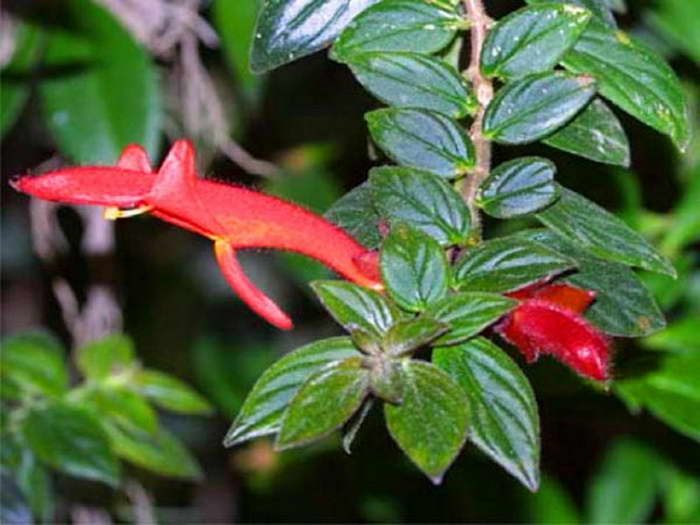

Columnea banksii photo
Shoots one meter long are dotted with small leaves of a light green hue. Flowers are yellow-orange.
Columnea Sheidiana Columnea schiedeana
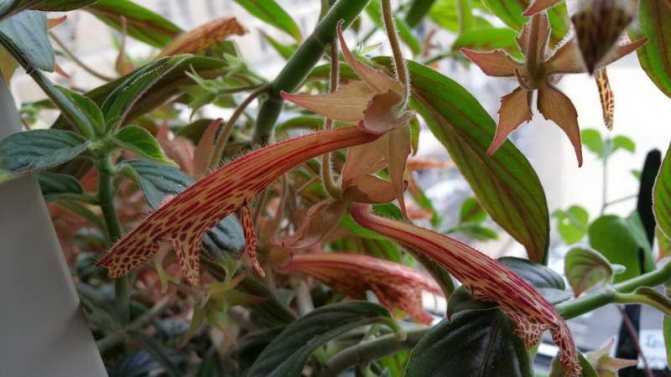

Columnea schida Columnea schiedeana photo
Shoots stretch to a length of 1.5 m, narrow leaves 10 cm long. The species differs in that the pile is reddish. Flowers, located along the entire length of the shoots, are sunny yellow in color with a tiger orange color.
Foreign selection. Rare varieties of columnea
In foreign breeding, the most graceful and rare varieties of all plants and flowers are provided. Basically, it is provided in the form of catalogs with prices indicated in them. It also contains rare varieties of kolumney. Now we will try to describe in more or less detail several types of these varieties:
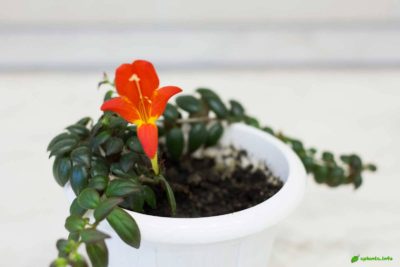

Aladdin's lamp has very bright large red-orange flowers. Leaves are medium in size, green with a brownish tint. Columbus Alps has large yellow flowers. And smaller green, elongated leaves with a red color on the inside. Apollo Columbus with large bright yellow (more lemon) flowers. Leaves are dark green. A flower with profuse flowering. Arguta has bright red flowers. The foliage is small, pointed at the bottom, flowering is dominated by foliage. Beta - This variety has small bright green leaves with a red inner side. The flowers are bright red. Carnival has large yellow flowers with a red border. The leaves are dark green (red on the back). The flowering of this species is very abundant. Firebird - a variety with red-scarlet flowers. Small dark leaves. Prevailing flowering.

